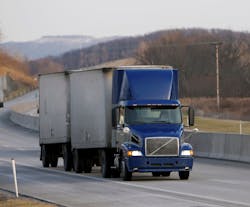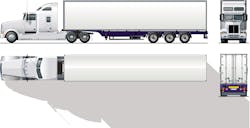DOT size and weight study ‘falls short,’ says new report
Nice try, but the U.S. Department of Transportation (DOT) report to Congress on federal truck size and weight limits could have come up with something other than that the data was insufficient to give lawmakers a substantial recommendation, says a newly released review.
While that June DOT report acknowledged its shortcomings, “a more comprehensive and useful response would have been possible,” according to the National Academies of Sciences, Engineering, and Medicine.
The new letter report from the Transportation Research Board (TRB) of the Academies does not take a position on whether or how to change current federal truck size and weight limits, but it does offer recommendations for improving estimates in each of the impact categories, in order to increase the value of any future truck size and weight studies.
Indeed, the DOT report could have provided a framework for understanding all the costs and benefits, the review committee found. Several components can be determined from results of the present and past studies, including
- a comprehensive list of the categories of costs and benefits;
- the features of a proposed regulatory change that influence each category;
- approximate sizes of impacts on shippers, truck operators, road users, and the public; and
- the categories that are likely to be critical to evaluating regulations.
The committee also identified assumptions and simplifications in the DOT study that might result in misleading estimates of infrastructure, traffic, and safety impacts.
DOT asked TRB to convene a committee to review the truck study.
Finally, the panel of academics, enforcement officials, and state transportation agency representatives recommended DOT should continue to support areas of research and data development begun in the present study in order to improve exposure data for estimating crash rates, to understand the relationship of crash frequency on a road to the traffic volume and mix of vehicle types, and to improve the cost-effectiveness of enforcement.
When the size and weight study was released, reaction from the trucking industry, shippers and highway safety groups was mixed. The American Trucking Assns. called it biased and political, and ATA was especially critical of DOT’s conclusion that, because the study results were inconclusive, no changes should be made to trailer length or truck weight limits.
Various legislation has been introduced in Congress that permit heavier trucks and longer trailers.
Groups opposed to bigger rigs supported that recommendation, however, and contend the TRB review backs them up.
“The reason so little data exists is that states and law enforcement have been unwilling to allow these bigger trucks on the roads, given the abundant evidence that they make passing, merging, and turning at intersections more difficult and take longer to stop,” said Shane Reese of the Coalition Against Bigger Trucks (CABT). “The TRB review does not support the charge by the ATA that the DOT study was biased against the trucking industry. If anything, it finds that the DOT likely underestimated the damage that longer, heavier trucks will do to bridges and that the DOT did not account for the major infrastructure and safety impacts on local communities.”
Proponents of longer trailers, however, also found portions of the review that supports the case for twin 33-footers.
"Every public policy maker should be troubled by the Academies findings that the Federal Highway Administration (FHWA) for the past five years has been ignoring a wealth of valuable research while failing to consider relevant and available data in preparing its MAP-21 Comprehensive Truck Size and Weight Report to Congress," said Ed Patru, spokesman for the Coalition for Efficient and Responsible Trucking. "The National Academies conclusion 'a more comprehensive and useful response would have been possible,' is an understatement, to say the least."
About the Author
Kevin Jones 1
Editor
Kevin has served as editor-in-chief of Trailer/Body Builders magazine since 2017—just the third editor in the magazine’s 60 years. He is also editorial director for Endeavor Business Media’s Commercial Vehicle group, which includes FleetOwner, Bulk Transporter, Refrigerated Transporter, American Trucker, and Fleet Maintenance magazines and websites.

